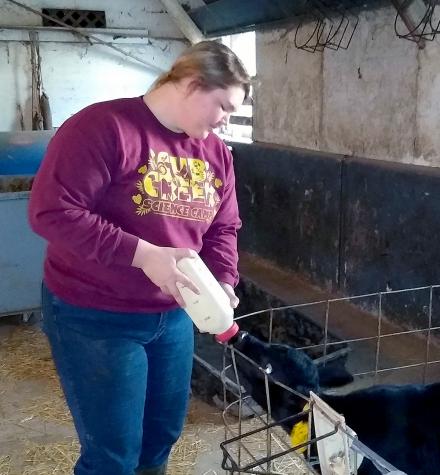COLUMBIA, Mo. – University of Missouri’s Foremost Dairy developed a colostrum management system that helps it far exceed Gold Standards set by the Dairy Calf and Heifer Association, says MU Extension dairy veterinarian Scott Poock.
A newborn calf’s first meal after birth is critical to reducing disease and death. Colostrum, or “first milk,” is rich in antibodies and protects the calf from disease until the calf’s own immune system begins to work. Colostrum also provides vital nutrients to get calves off to a healthy start.
The Foremost Dairy Research Center, in Columbia, surpassed industry standards for newborn calves using a written calf-colostrum plan developed by the dairy’s manager, John Denbigh.
After a recent webinar on colostrum management by Sandra Godden of the University of Minnesota, MU Production Medicine students under Poock’s direction compared Foremost’s numbers to new data that will be published in the Journal of Dairy Science.
“I am always looking for new ways to use data to evaluate production on farms,” Poock said. “This new research helps to ‘slice and dice’ the data to allow for a better analysis of farms in regard to their calf management.”
In the Journal of Dairy Science paper, a group of calf specialists say the current simple pass/fail test to categorize the results of total protein, antibody levels or Brix readings is insufficient. Currently, veterinarians and producers recommend that calves should test greater than 5.2 g/dL total protein at 1-7 days of age, correlating to adequate absorption of antibodies from colostrum.
“The current system does not have the detail that the new system analyzes,” Poock said. “Not only do Foremost calves exceed the old system. They exceed the new recommendations.”
In Denbigh’s plan, colostrum is harvested from the dam, or mother, of the calf. When the dam’s colostrum is unavailable, Foremost uses frozen colostrum thawed at 120 F. They use a Brix refractometer to check quality and set high-quality “Green” colostrum equal to or greater than 50 g/L of antibodies (IgG) as the standard. Munashe Chigerwe, formerly of Mizzou’s College of Veterinary Medicine and now a professor at University of California-Davis, showed that cows in the Foremost herd produce colostrum at an average of 65-68 g/L of antibodies.
Excess colostrum is frozen and marked with the cow ID, date and quality. Calves receive 1 gallon of colostrum as soon as possible after birth. If they do not drink the entire gallon, the remains are offered within six to 12 hours of birth.
The Dairy Calf and Heifer Association set goals of less than 10% pneumonia. Foremost’s rate for the past year was 3%. The association’s goal for scours was under 15%. Foremost’s was 4.4%. Similary, the association’s goal for death rates was under 3%, and Foremost’s death rate was only 1.5%.
“These low numbers are a result of the tremendous colostrum management at the farm,” says Poock.
Ideally, calves receive colostrum from the dam of the calf. Getting the colostrum into the calf shortly after birth reduces levels of pneumonia, scours and death.
Photo available for this release:
Sara Estes
MU student and Foremost Dairy worker Sara Estes bottle feeds colostrum to a newborn calf. The dairy's colostrum management system reduces scours, pneumonia and death levels by feeding high-quality colostrum to calves soon after birth. Photo courtesy of Scott Poock.
